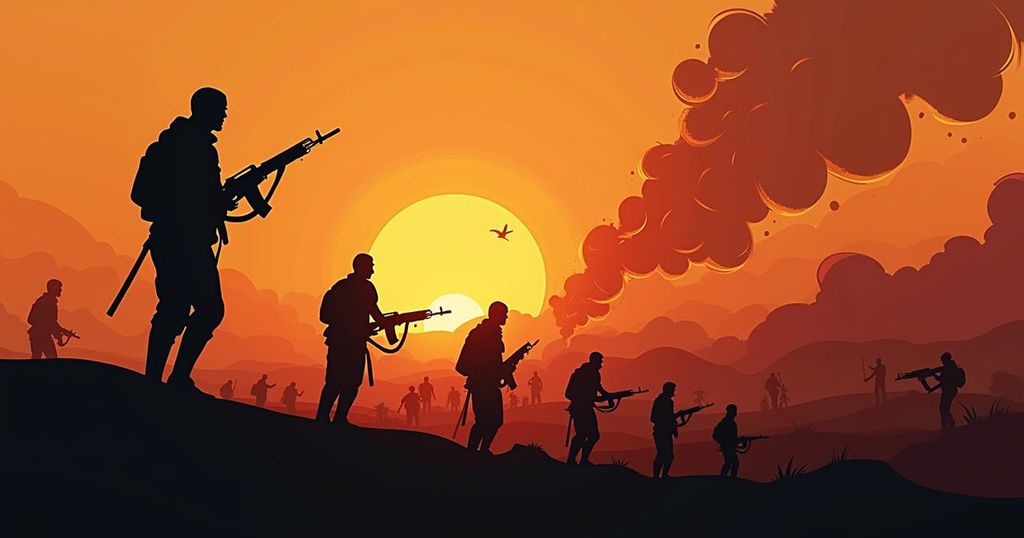The recent week has seen escalating tensions in the Middle East, characterized by the assassination of Hezbollah leader Hassan Nasrallah, Israel’s invasion of Lebanon, and Iranian missile strikes on Israel. This series of events has led to significant casualties and displacement, while efforts for diplomatic resolution have faltered. The geopolitical landscape suggests a precarious balance of power, with regional actors grappling with increased military engagement amid calls for restraint from international powers.
In the past week, tensions in the Middle East have surged alarmingly, creating a situation that many perceive as a step toward all-out war. The death of Hezbollah leader Hassan Nasrallah, Israeli military incursions into Lebanon, and Iran’s missile bombardment of Israel represent critical escalations in the ongoing conflict. Amid these grave developments, Western and regional powers, spearheaded by the United States, have advocated for de-escalation, yet their initiatives appear to have been largely ineffective. This article delineates the timeline of escalating hostilities over the past week and its implications for regional stability. On the evening of September 27, a devastating barrage of explosions in southern Beirut culminated in the assassination of Hassan Nasrallah. The targeted attack, which struck an underground bunker, resulted in significant destruction and claimed numerous lives, further exacerbating the humanitarian crisis in Lebanon. Following the assassination, hopes for diplomatic negotiations faded quickly as Israeli Prime Minister Benjamin Netanyahu departed from the United Nations General Assembly, signaling a pivot towards military action. By Monday night, Israeli forces commenced a ground invasion of Lebanon, declaring the operations would be “limited and targeted.” The Israel Defense Forces (IDF) aimed to dismantle Hezbollah’s capabilities to launch attacks against Israel, following a consistent pattern of hostilities that had escalated since the onset of the Gaza conflict nearly a year prior. Consequently, an estimated 1.2 million people have been displaced within Lebanon due to the violence. This invasion marks a significant escalation, as Israeli troops are engaged on two fronts—Gaza and Lebanon—something that has not occurred in decades. The following day, Iran responded by launching a substantial missile strike, deploying nearly 200 ballistic missiles toward Israeli targets, leading to widespread alarm throughout the nation. While Israel’s air defense systems intercepted most of these missiles, a few managed to breach defenses, causing casualties and damage. This retaliation by Iran signifies an attempt to bolster its regional influence amidst deteriorating proxy relationships such as with Hezbollah. The strategic calculations around these assaults indicate a precarious balance of power; neither Israel nor Iran wishes to escalate the situation to an uncontrollable level but both leaders are showing increased military assertiveness. Each is aware of the catastrophic consequences that an uncontrolled military conflict could unleash. Despite Hezbollah’s substantial losses, the organization has expressed its commitment to continue its resistance in Lebanon. History suggests that while Israeli forces may penetrate Lebanese territory, an eventual withdrawal could prove challenging. Meanwhile, significant international actors remain cautiously observant of Israel’s strategy, especially as U.S. President Joe Biden has urged restraint regarding potential Israeli strikes on Iran’s nuclear infrastructure. The larger picture presents a complex web of conflicts involving various regional players, including Gaza, Lebanon, and Iran. While a comprehensive regional conflict appears to be on the horizon, the exact path forward remains uncertain, with numerous factions engaged in a delicate interplay of geopolitical interests.
The tensions in the Middle East have escalated dramatically over the last year, propelled by a series of violent confrontations primarily centered around the ongoing conflict in Gaza. The rivalry between Israel and Hezbollah has resurfaced alongside Iran’s increased military support for its proxies in the region, creating a perilous security environment. The loss of significant leaders, such as the assassination of Hassan Nasrallah, exacerbates the already volatile situation, further destabilizing existing power structures and prompting urgent calls for restraint from the international community. The involvement of major powers such as the United States in mediating the situation adds another layer of complexity, as regional actors navigate their responses in a landscape fraught with potential for wider conflict.
In conclusion, the past week has marked a critical juncture in Middle Eastern geopolitics, with significant events that have exacerbated the potential for all-out war. The assassination of Hassan Nasrallah, Israel’s ground invasion of Lebanon, and Iran’s missile attacks upon Israel have intensified a complex web of conflict involving multiple regional actors. Despite calls for de-escalation from international powers, the reality on the ground illustrates a difficult path forward with ongoing hostilities and pronounced regional volatility. As the situation continues to develop, the implications for regional security and international involvement remain profound and unpredictable.
Original Source: www.bbc.com







